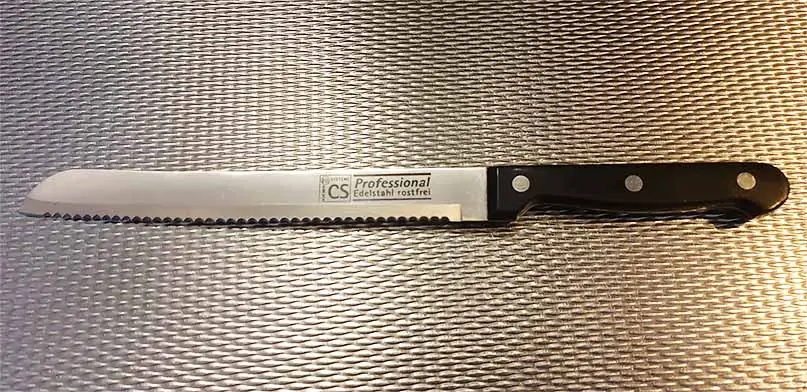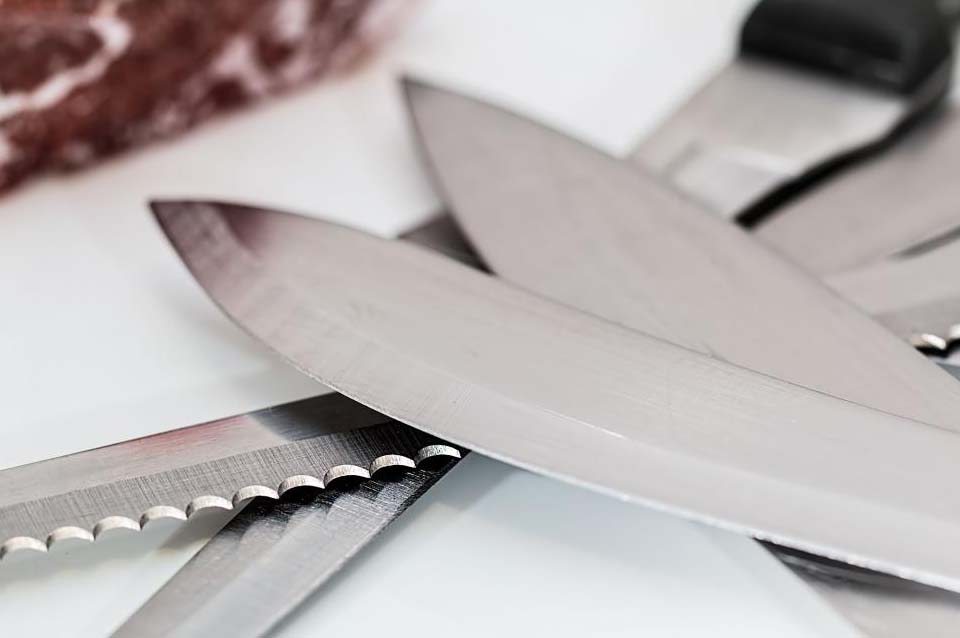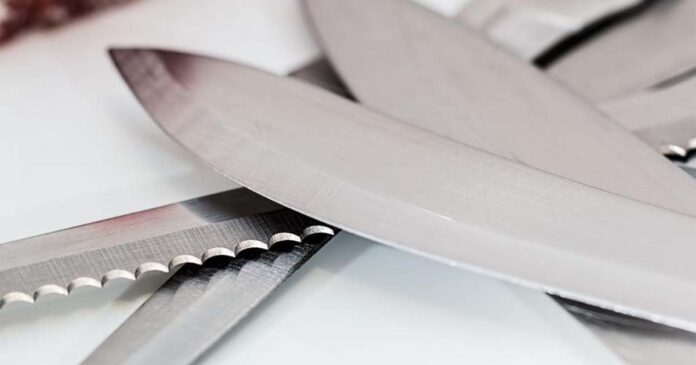For a ripe tomato with thin skin, a serrated blade is just the right tool because it cuts neatly without crushing the fruit. Same with fresh loaf of delicious bread. And it’s not just for bread and tomatoes; when I’m carving a roast, cutting oranges into wedges, or breaking up a bar of chocolate, the serrated knife is the best tool to use. Read on to learn more!
This web portal is supported by its readers, and is a part of the Amazon Services LLC Associates Program and the eBay Partner Network. When you buy using links on our site, we may earn an affiliate commission!
Slicing Fresh Bread
When I cut fresh bread, I need to be very careful to do it right. It’s important to use a serrated knife because it can cut through the crust easily without smashing the bread. The teeth on the knife help it grab onto the crust so I can move the knife back and forth without pushing down too hard. This way, I get even slices that look good and are the perfect thickness, whether they’re thin for light spreads or thick for big sandwiches.
The pointed teeth on the blade are important because they don’t mess up the bread’s shape by knocking loose too many crumbs. I always make sure the knife is sharp and that I’m cutting steadily, so I don’t end up with uneven edges that make the bread slices look bad. Once you get good at this, it even makes cutting other soft things, like ripe tomatoes, much easier.
When I’m shopping for a serrated knife, I look for one with sharp, well-defined teeth and a comfortable handle. A good option is the Victorinox Swiss Army Bread Knife, which I’ve found stays sharp for a long time and handles well during slicing.
Cutting Ripe Tomatoes
Cutting ripe tomatoes can be tough, but using a serrated knife is oftentimes the best way to do it. It’s because a serrated knife has a toothed edge that grips the tomato skin right away, so it doesn’t slip. Plus, it cuts through the tomato gently, which means it keeps its shape and doesn’t get squashed. This makes the cutting faster and works great no matter what type of a tomato you’re cutting.
I really recommend using a serrated knife for tomatoes because it lets you make neat slices or cubes that look good and keep the texture we all love in our dishes. For example, if you’re making a sandwich or a salad, you want those tomato slices to be perfect, not mushy or torn.
Carving Roasted Meats

When I’m slicing up roast meats, a serrated knife is my go-to tool because it makes precise cuts without tearing the meat apart. The knife’s saw-like edge really holds onto the meat’s outer layer, which helps you cut smoothly and keep every slice intact. It’s important to keep the knife’s teeth sharp for easy cutting that doesn’t need a lot of muscle.
Cutting meat this way doesn’t just look better on the plate; it also keeps all the tasty juices locked in, which is what anyone who loves good food is looking for.
I’ve found that a medium-sized serrated knife is best because it’s easy to handle, especially when I’ve to cut around bones or be extra careful. From personal experience, I’d recommend something like the Victorinox Fibrox Pro Slicing Knife with a serrated edge. It’s a fantastic tool that has helped me serve up countless dinners without a hitch.
Segmenting Citrus Fruits
When I’m prepping oranges or other citrus fruits, I’ve found that a serrated knife is a game-changer – believe me! It’s really good for cutting cleanly and not wasting any of the fruit. Here’s why a serrated knife works so well:
- Less Mess: Its saw-tooth edge means you don’t lose much juice or fruit bits by squeezing the fruit too much.
- Neat Slices: The knife slides through the fruit’s skin and membranes, so you get nice, tidy pieces.
- Works for All Sizes: It doesn’t matter if you’re cutting small limes or big grapefruits; a good serrated knife of the right size can handle them all.
- Better Grip: The serrated edge makes it easier to hold onto the fruit while you’re cutting, even if it’s wet or slippery.
Using a serrated knife makes the job easier and gives you great results. It’s a simple choice that makes a big difference.
Chopping Chocolate or Chocolate Blocks

When I cut up chocolate blocks for cooking, I like to use a serrated knife because it works really well. The knife’s teeth grab onto the chocolate, so I can slice it neatly without pushing too hard, which might break the chocolate into bits and pieces.
With time I’ve learned to use a gentle back-and-forth motion, like sawing, which keeps the chocolate from breaking apart and gives me even pieces that can melt smoothly or look good as decorations.
Frequently Asked Questions
Can Serrated Knives Be Effectively Sharpened at Home, and if So, What Is the Best Method to Do This?
Yes, you can definitely sharpen your serrated knives at home. I personally use a ceramic honing rod because it just works well. It sharpens each serration carefully, making the knife as sharp as new. It’s important to have a sharp knife because it makes cutting easier and safer. For example, if you’re slicing bread, a sharp serrated knife will cut through it cleanly without squashing it.
How Do I Choose the Right Serrated Knife for Delicate Pastries and Cakes Without Crushing Them?
When I’m looking for the perfect knife to slice through soft pastries and cakes, I go for a serrated knife. The reason is simple: you want to avoid squishing your fluffy creations. The knife should have small, sharp teeth and be able to cut smoothly – kind of like a saw. This way, I can make sure each slice is neat and tidy, keeping the pastry’s shape and texture just right.
Are There Any Safety Tips Specific to Handling Serrated Knives Compared to Straight-Edged Knives?
Certainly! When using a serrated knife, it’s crucial to hold it tightly to keep it stable. Instead of pressing down hard, you should simply move the knife back and forth like a saw. This technique helps you cut more effectively and reduces the chance of the knife slipping, which could cause an injury. It’s also good to use a cutting board that doesn’t slip, and if possible, choose a knife with a handle that’s comfortable and non-slip for extra safety. Remember, a serrated blade is perfect for cutting bread or tomatoes because it grips the surface better than a straight-edged knife, making the task easier and safer.
What Are the Differences in Blade Length and Serration Patterns, and How Do They Affect the Knife’s Performance in the Kitchen?
In my time in the kitchen, I’ve found that the size and shape of a knife’s blade really matter. A long blade with big, rough serrations is perfect for cutting through crusty bread without squashing it. On the other hand, if you want to slice something soft like a tomato without making a mess, you’ll want a knife with small, fine serrations for a clean cut. It’s all about using the right tool for the job – like choosing a serrated bread knife for loaves and a paring knife with a smooth edge for peeling and slicing fruits. These details make all the difference in preparing food efficiently and safely.
Can Serrated Knives Be Used for Peeling Fruits and Vegetables, or Should They Be Reserved for Slicing Tasks Only?
Serrated knives aren’t the best choice for peeling fruits and veggies. They’re made for cutting through things with a sawing motion, like bread or tomatoes. When you’re peeling, you want a smooth cut, and that’s where a straight-edged knife comes in handy. It gives you the control you need to peel thinly and avoid taking off too much of the fruit or vegetable. A good peeler or a paring knife would be a better option. They’re designed to peel easily and with precision, helping you get just the skin off without wasting any of the good stuff underneath.


